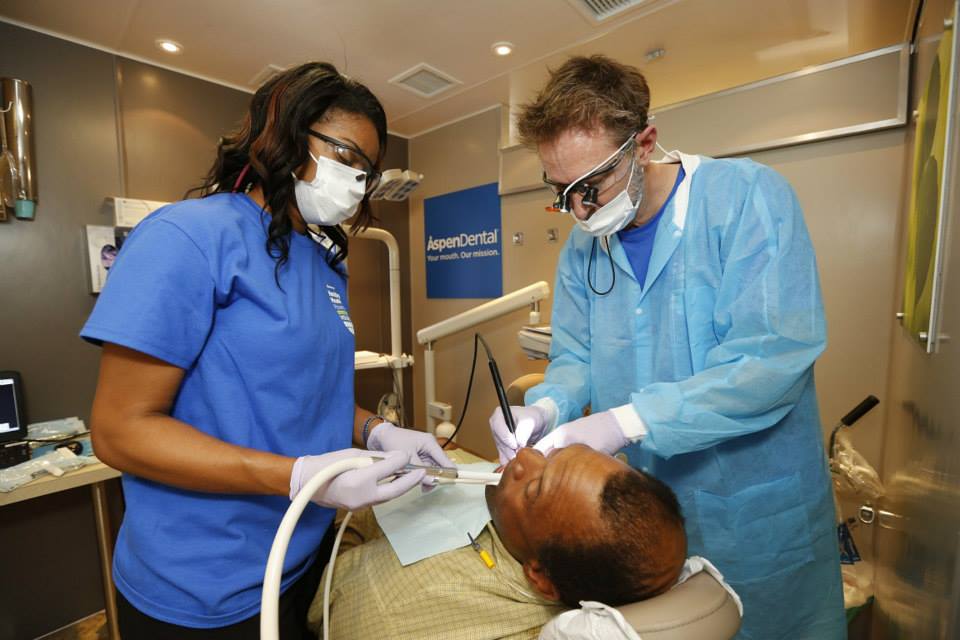Understanding the Dental Crown Procedure: What to Expect


Main image courtesy of Fermelia Dental.
If you’ve experienced damage to your teeth, or have been dealing with a tooth weakened by disease or decay, your dentist has probably spoken to you about dental crowns. Crowns are a tooth replacement option that can help you get the functionality back of your tooth or teeth. When teeth are damaged or are weakened due to decay, they may need the assistance of a crown to restore them.
But what exactly are dental crowns, and what can you expect from the dental crown procedure? In this Aspen Dental guide, we’re going to go over:

Dental crowns are typically placed on top of a tooth or teeth that are damaged and need to be protected. They are also used to restore the shape of your tooth if it has been broken or needed to be reshaped by your dentist due to decay. It may be helpful to think of dental crowns as caps or helmets that are used to safely protect your tooth and restore its ability to bite and chew easily.
Dental crowns can also give you back confidence in your smile. If you’ve been dealing with cracks or teeth that are damaged, you may no longer feel confident when talking and speaking. Dental crowns can allow you to smile and speak with others with ease and confidence again.
A dental crown is designed to bring back the strength and appearance of your natural tooth, and they are a popular tooth replacement option. You can get a dental crown on any tooth, regardless of whether it’s at the front of your mouth or in towards the back.
Your dentist might recommend you for a dental crown procedure if you:
These are all viable reasons you might want to get a dental crown. But why would you choose this tooth replacement option over another?
Now that you know a little more about what a dental crown is, let’s learn a little more about the benefits of getting a dental crown. You’ll want to discuss whether this is a good option for you in detail with your dentist, as everyone’s dental needs are different.
Dental crowns are useful for many reasons, one of them being to protect your tooth after a procedure. If you’ve recently had a cavity filled or had a root canal procedure, your tooth may be vulnerable to additional damage or decay.
Because of this your dentist may decide that putting a crown on the tooth or teeth that needed the filling or root canal is a good idea. Once the underlying problem causing you discomfort is addressed, a crown can be placed on to further protect the vulnerable tooth. With a crown in place, you’ll not only get the full appearance of your natural teeth back, but you’ll have the strength of the crown as well.
Having a crown on your vulnerable tooth can also help alleviate any sensitivity that might have developed due to a filling or root canal.
One of the most common reasons for getting dental crowns is to cap a damaged or decaying tooth, protecting it and strengthening it in the process. Whether you have a chipped tooth, or have had much of your tooth removed due to decay, a dental cap is a great way to seal it going forward.
If this is the case, your dentist will first prepare your tooth to receive the crown by ensuring it is a good, tight fit. This is done by removing damaged parts, and shaping the tooth so that the crown is easily placed on top. Once it is snug and attached, the vulnerable tooth underneath it is protected from future damage.

Although many people use dental crowns to protect their damaged teeth, they can also be used if you have gaps between your teeth, or if they are misshapen or discolored. Speak to your dentist about what your cosmetic dental goals are, and they may decide that dental crowns can help you achieve them.
Having your confident smile back with the help of crowns is a good investment in your overall health and can make a difference in your quality of life.
The dental crown procedure (more on that below) is a very straightforward process and is not as intense as you might think. Depending on your unique situation, your tooth or teeth will be prepared to receive the crown by being first prepared and altered to a shape that will offer a good seal. The crowns are then cast and you will need to return for their placement.
If you are required to return for their placement, your dentist will make sure to install a temporary crown so that you can still eat and drink, and go about your daily activities.
Each dental crown you get will be custom made to fit the particular tooth that needs it. There are a variety of materials that crowns can be made out of, and you and your dentist can discuss which option will work best for you.
One of the major benefits of dental crowns is that they are considered a mostly permanent tooth restoration method. Although the length of time a crown lasts depends on the type of material it consists of, how well you prevent decay and how intensely you bite and chew your food. Crowns are a very stable and long lasting option, whether you need to fix a damaged tooth, or want to realign your smile.
As we’ve seen, depending on your situation, there are many advantages to getting a dental crown. However it should be pointed out that:
If you still feel that dental crowns could be the solution you need, you and your dentist will then need to decide on what kind of material it should be made out of.
Dental crowns are a very versatile option when it comes to a long lasting tooth replacement option. Depending on your situation, you can choose from a variety of materials designed to help protect and strengthen your natural tooth.
One drawback of getting a metal crown is that it will be a different color from the rest of your teeth. However, if you need a crown for one of your upper or lower back molars, this might be a good choice.
Depending on where you need your crown, your dentist will recommend a material that’s best for you based on:
After considering these, your dentist can help you choose an option that will give you a long lasting fix for your tooth.
In addition to dental crowns, your dentist may also discuss with you an onlay or a ¾ crown. If the majority of your tooth is still healthy, you may not need a crown to cover all of it. Instead, your dentist can also give you an onlay. This is typically done if the remaining tooth is healthy and is only slightly damaged, for example if one of the molar cusps fractures off. However, onlays are not considered as durable or as long lasting a crown as other types, so you'll need to take that into consideration as well.
If you’re going to get a crown placed on your teeth, that’s great news because you’re on your way to restoring the appearance and functionality of your teeth. The dental crown procedure, as we mentioned earlier, is a straightforward procedure. Afterwards, you can expect to walk away with your tooth (or teeth) restored, giving you back your confident smile. Source : https://www.healthline.com/find-care/articles/dentists/dental-crown#the-procedure
There are two ways in which you might receive a dental crown, in one visit or spread out over two visits.
After meeting with your dentist to discuss your tooth restoration options, if they decide that a crown is your best bet, they will recommend one of two options. Either a traditional two-visit dental crown procedure, or a same-day dental crown procedure. If they decide that a two-day procedure is required for your situation, first they will inspect the tooth and clean up any decay or damage.
Then your dentist will take X-rays of the tooth and the surrounding bone, and determine if there is more extensive work that needs to be done before a cap is placed. This would include a root canal procedure if the decay or damage is extensive.
After this step, your dentist will then prepare the tooth that will receive the cap by filing it down in order to ensure a good fit. How much of your tooth is filed down will depend on the material that your crown will be made out of, and how extensive the previous damage or decay.
If your dentist decides that you need additional filling material to help build up the natural tooth that you do have left, they will do that as well.
Once that is complete, an impression or digital images will be taken of the tooth that will get the crown, as well as the surrounding teeth and the opposite teeth. This is done to ensure that your bite will not be affected by your new crown. Your impression or digital images will then be used to make your crown.
In the meantime, you will be given a temporary dental crown while you wait for the arrival of your permanent ones. With your temporary crowns, you will be able to eat and speak normally, but your dentist may recommend not eating hard or sticky foods in order to prevent a potential crack or dislodging in your temporary crown.
Once your permanent crowns are ready, you’ll visit your dentist once again. Now your crown is ready to be attached. After removing the temporary crown, they’ll ensure your permanent one fits well and is the color you were expecting. Then your dentist will cement the permanent crown to your tooth.
Afterwards you can leave knowing that your tooth (or teeth) are protected from additional damage or decay, and can go back to eating normally.
The first step of getting your dental crown is to visit your dentist and have a consultation. Once they know what your situation is, they can determine whether or not a crown is your best option. If they believe it is, they’ll consider a variety of factors before determining what type of material they should use for your crown.
After that, your dentist will remove any damage or decay around the teeth, so that it is healthy. Then they’ll shape the tooth so that the crown will fit.
Next your dentist will take digital images of your affected teeth so that they can be sure to get the right size and shape for your crown. With this 3D model, they’ll be able to then construct the crown right there in the office. Typically, the crown is then carved by a machine from ceramic. Once your crown is ready (anywhere from an hour to two hours) you can have it cemented on the same day.
We’ve discussed how your dentist will place a dental crown on one tooth, but what if you need a dental crown bridge? This type of tooth restoration procedure is also very straightforward, however an artificial tooth (or teeth) will be held in place in between two crowns, creating the bridge structure.
If you have a missing tooth or teeth in between two damaged or decaying teeth, your dentist might opt for this type of procedure as opposed to a partial denture. To start, they’ll need to take measurements, molds, and images of your teeth that require the dental crown bridge. Like the regular dental crowns, this can involve X-rays, impressions, or digital images of your affected teeth, as well as your surrounding and opposite teeth. This is done to ensure that your bite will still be the same with your dental crown bridge.
Once the bridge is ready to be placed, your dentist will first prepare the teeth that will receive the crowns. This includes removing any damaged or decaying material, and filing down the teeth so that they will properly hold the bridge in place. They will then cement the crowns to your teeth that hold the bridge in place, with the artificial teeth in between. This is a great option for you if you want something that feels more natural than a partial denture.
With a dental crown bridge, you can expect to get back your ability to chew, speak, and smile with confidence.
Now that you’ve got your crowns in place, how should you go about caring for them? Your dentist will give you specifics, but you can expect to care for your dental crowns just as you would your natural teeth. This means:
Dental crowns are a good idea for anyone who wants to protect their teeth from additional damage or decay. If you have a damaged tooth, or are worried about whether or not you could benefit from a crown, speak to your dentist. Crowns are a minimally invasive way to strengthen your teeth and restore your confident smile. Your welcome starts here

Your new patient visit at Aspen Dental is our most important appointment together.